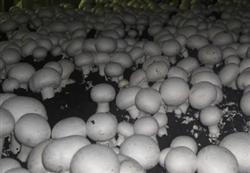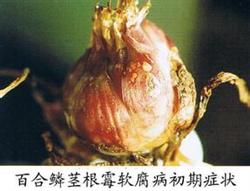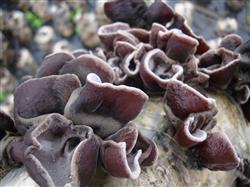Cultivation of Agaricus bisporus with wheat straw and cow manure

Double spore mushroom, also known as mushroom, white mushroom, foreign mushroom. It is nutritious, delicious and popular in the world. If wheat straw and cow manure are used as raw materials to cultivate Pleurotus ostreatus, the investment is low, the benefit is high, and it is worth popularizing. First, to build a mushroom house, choose a place with high and dry terrain and plenty of water, and build a house in a place from north to south. The room width is 2.4 meters (two beds) or 4.5 meters (three beds), the length depends on the terrain, the specific construction method is the same as the general Pleurotus ostreatus plastic shed. In order to increase the cultivation area, the retaining walls on both sides can be properly raised, and a simple bed frame can be set up with wooden sticks, covered with corn straw, Reed foil, etc., with 2-3 layers and a spacing of 60 cm. Second, the composting and fermentation of culture materials. Materials are prepared as follows: 100 square meters of dry wheat straw 1 500 kg, dried cow dung 1 000 kg, urea 15 kg 20 kg, calcium superphosphate 37.5 kg, gypsum powder 40 kg, calcium carbonate 45 kg, quicklime 20 kg. two。 The construction of the pile was carried out in the middle and late July. Two days before the construction, the wheat straw and cow dung should be pre-wet. The humidity was as follows: holding cow dung in hand, there were 4: 5 dripping water between fingers; when the wheat straw was twisted by hand, the water was dripping. Material pile north-south, 2.5 meters wide, 7.0 meters long 8.0 meters, 1.5 meters high, a total of 7 layers. The first layer first spread 30 cm thick wheat straw on the ground, then sprinkled urea (accounting for 1 beat 7 of the total), and then sprinkled 150 kg of cow dung. The thickness of the second to seventh layer of wheat straw was 20 cm, and the amount of cow dung was 2 to 6 layers, with 100 kg of each layer. The rest was covered in the seventh layer, and the amount of urea in each layer was the same as that in the first layer. The temperature increased by 75 ℃ after the reactor was built, and decreased after 5 to 6 days. 3. Seven days after turning the pile, 15 kg of quicklime was added to the pile for the first time (the rest of the bed surface). When raw gypsum powder was added for the second time, the stack width was reduced to 1.5 × 2.0 meters, the length was 7.0 meters, and the height remained unchanged. Add calcium superphosphate for the third time. If the material temperature exceeds 60 ℃, set up a row of pores every 1.5m. Add calcium carbonate for the fourth time (2 of the total amount). Adjust pH to ph 7.2-8.0 for the fifth time. Third, one week before sowing mushroom material into the room, thoroughly disinfect the mushroom room with 1.2% copper sulfate or 500 times carbendazim. Then move the material into the room, spread 15cm to 20cm thick, wait for the material temperature to drop below 28 ℃, and sow seeds when there is no smell of ammonia in the material. Use 1: 1.5 bottles of bacteria per square meter, first sprinkle the dosage of 2Accord 3 evenly on the material surface, shake the material surface by hand, make the bacteria sink 3cm to 5cm, then sprinkle the remaining bacteria on the material surface, gently pat it flat with a stick. Fourth, management after sowing 1. Within 3 days after sowing, the optimum temperature for mycelium growth was 20: 25 ℃, and the relative humidity was 70% and 75%. two。 Soil mulching was carried out about 13-15 days after sowing (mycelium feeding 2 + 3). The soil quality is suitable for loam or clay loam, which needs 3 to 3.5 cubic meters for every 100 square meters. The particle size of coarse soil is 1 cm 1.5 cm, accounting for 2 cm, while that of fine soil is 0.3 cm, 0.5 cm, accounting for 1 cm. Add the remaining calcium carbonate and 0.25 kg dichlorvos to the soil, spray the water well, mix well, the moisture of the soil particles should be round and flat, then cover with a film for 24 hours. When covering the soil, the thickness of the material surface soil is 3-3.5 cm, which is consistent with the requirements. 3. The management after covering the soil adjusts the soil temperature in the first three days after covering the soil, so that the water content reaches 16%-18%, that is, the coarse soil has no white heart, rubbed round, pinched flat, without cracks; fine soil will crack when it is pinched. About half a month after covering the soil, part of the hyphae became thicker, and the mushroom water was sprayed in time when forming a pea big boy body, generally 1: 1.5 kg / m2 (depending on the fungus material), divided into 2 days, sprayed 3 times a day, 4 times a day, and then ventilated for 1 hour and 1.5 hours. Six days later, when the fruiting body grew to the size of soybeans, the mushroom water was sprayed again, generally 0.25-0.5 kg / m2. After 10 days, spray water according to the amount of mushrooms, spray more mushrooms, spray less mushrooms, and ventilate for 30 minutes after spraying. After half a month of soil mulching, the suitable temperature for fruiting body growth was 1318 ℃, and the relative humidity was about 90%. 4. Harvest and post-harvest management when the mushroom cover is up to 2cm long and harvested before opening the umbrella. After the end of this tide mushroom, remove the dead mushroom and residual mushroom root on the mushroom surface in time, fill the hole with coarse and fine soil, spray water again, and wait for the mushroom to emerge under the tide. 5. Overwintering and spring management mushroom shed overwintering should be strengthened to prevent heavy snow collapse. The mushroom bed was loosened once and the cover was increased by 1.0. Centimeters of new fine soil. Before startling, check the water content in the material, sprinkle 50 grams of plant ash per square meter and spray water to moisturize. 1000 times dichlorvos was sprayed within 3 days after sting, and dichlorvos drug strips were hung in the ventilated place to prevent insect pests. The management after the temperature rise is the same as that of soil mulching in autumn. The harvest ends in June.
- Prev

Control methods of Rhizopus soft rot of lily bulb
First, the symptoms of damage: during the storage or transportation of the lily bulb, there are primary water stains on the outer skin, and then the color becomes darker, with a slightly pungent smell, the bulb becomes soft, and in serious cases, the bulb has destructive decay, and sometimes there is a thick mycelium layer on the bulb, that is, the cyst peduncle and sporangium of the pathogen. Second, the shape of the pathogen is special.
- Next

Cultivation of Auricularia auricula with straw
After the autumn harvest, there is a large amount of straw left in the countryside, which is a great pity to be thrown away. The effect of cultivating Auricularia auricula with straw is very good, and it is also a way for farmers to get rich. The practice shows that generally, more than 10 kg of dried Auricularia auricula can be harvested per 100 kg of rice straw, and the high-yielding ones can obtain a net income of more than 200 yuan.
Related
- Fuxing push coffee new agricultural production and marketing class: lack of small-scale processing plants
- Jujube rice field leisure farm deep ploughing Yilan for five years to create a space for organic food and play
- Nongyu Farm-A trial of organic papaya for brave women with advanced technology
- Four points for attention in the prevention and control of diseases and insect pests of edible fungi
- How to add nutrient solution to Edible Fungi
- Is there any good way to control edible fungus mites?
- Open Inoculation Technology of Edible Fungi
- Is there any clever way to use fertilizer for edible fungus in winter?
- What agents are used to kill the pathogens of edible fungi in the mushroom shed?
- Rapid drying of Edible Fungi

